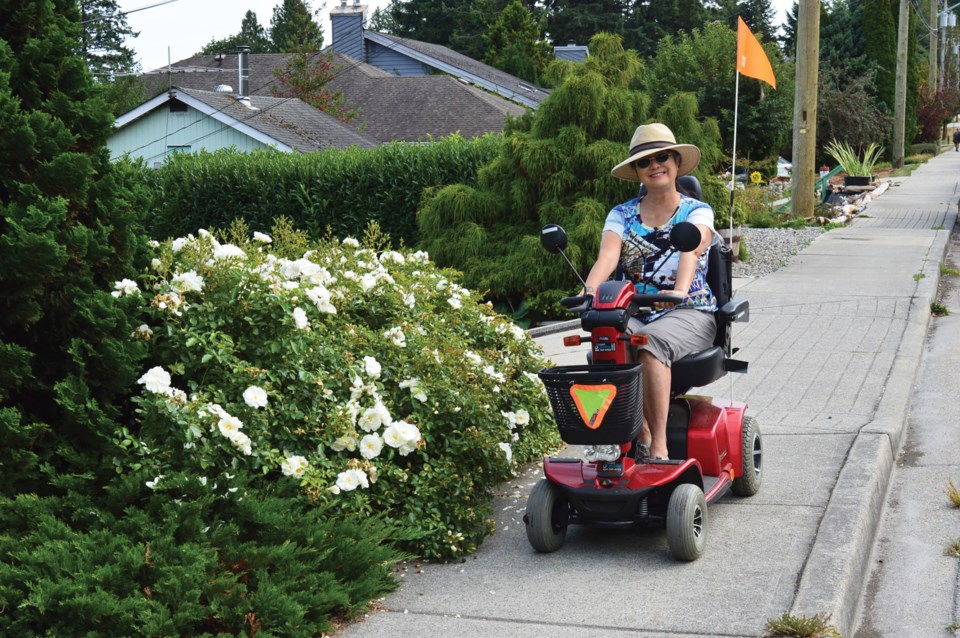“Before you judge a man, walk a mile in his shoes.” How about if you can’t walk? What about other challenges like being sight or hearing impaired? Without focusing on the literal aspect of this saying, it reminds us to practise empathy and try to understand someone else’s experiences and challenges.
My elderly father used an electric scooter to get around Gibsons when walking became difficult. My mother now uses that scooter on occasion and I often see other residents with their scooters and wheelchairs around town. To better understand the world from their perspective, I decided to “roll a mile on his wheels.” I spent several hours one sunny afternoon travelling around Gibsons on an electric scooter to investigate how accessible various locations are. Here’s what I discovered.
Gibsons has some geographic challenges in the big hills that separate lower and upper Gibsons. The scooter experts advised that some roads, such as School Road, are too steep for electric scooters and wheelchairs so look for alternatives before heading out. It is advisable to make sure that your scooter or motorized wheelchair has the power and battery capacity to make it up and down safely. Batteries have a shorter charge time for heavier weights or hilly terrain. If you think you will be out for a long time, take your charger with you. Many merchants are happy to let you use their plug-ins to recharge.
Many stores and restaurants were accessible or partly accessible but there were a few challenges. Some stores had merchandise arranged right near the entranceway so that navigating my scooter into the store was not possible. In those instances I had to just peer inside from the sidewalk. In other cases, the scooter could get in but it was difficult to turn around or navigate the aisles. The fear of knocking things over was constant in these instances. The length of the scooter is longer than an electric wheelchair and needs more room to turn around. The advantage for scooters, however, is their increased capacity for weight and battery life, which is important for our geography. The main seating or “fun” part of restaurants and bars were completely inaccessible for a few locations. In some locations, only the patio was accessible (which might make dining during the winter quite chilly).
The grocery stores and pharmacies were accessible with friendly staff who offered assistance and wide aisles that easily accommodated an electric scooter. One can also order merchandise online and have it delivered or pick it up at the customer service desk. This type of service is helpful, but what if you are a shopper who likes to peruse each aisle or just get out of the house for a change of scenery?
One of the main challenges encountered was locating accessible washrooms. In lower Gibsons, there is one in the public market and one in the public library. In upper Gibsons, they are located in the recreational centre and Sunnycrest Mall. There were other washrooms with a “wheelchair” symbol on the door, but appeared too small to attempt to use. Other challenges encountered include: sandwich board advertising blocking the way and bushes overgrowing the sidewalk. This made me think about how difficult it would be to travel on sidewalks where the snow has not been cleared in winter.
It’s one thing to know where the accessible places are in Gibsons, but what happens when you travel somewhere else? Well, there’s an app for that! AccessNow is a Toronto based company that just received over $2 million in investment funding from the federal government to expand across Canada. There are plenty of navigation apps available, but this one is specific to finding mobility-friendly services and locations. It’s free and any user can add a location and rate it for accessibility.
During my outing on wheels, I found myself feeling excluded and in some instances unwelcome. This experiment helped me to understand some of the challenges faced by people with disabilities. Many of the barriers I encountered could be overcome with minor adjustments, while some may not be possible due to cost or other reasons. Federally funded grants from the Enabling Accessibility Fund or private investments may help to support entities that aim to increase accessibility.
By decreasing or eliminating barriers, people with disabilities will be able to participate more in their communities and have increased opportunities for employment. Being inclusive is also friendly and great for business. With our aging population, it’s likely that more and more people may rely on scooters to get around. So come on, Sunshine Coast. Let’s be proactive and do as much as possible to make our public places more accessible.



